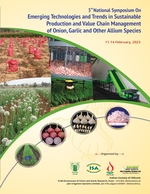Pest and disease management
Pest and disease management is crucial for obtaining higher marketable bulb yield and good quality bulbs. Major pests and diseases of onion, their symptoms and management practices are given in Table and Fig. In addition, following points need to be considered for pest and disease management.
1. Initiate foliar sprays of pesticide from 30 days after transplanting or as soon as pest/disease appears in the field
2. Spray at 10-15 days interval depending upon the intensity of pest/disease
3. Always add spreader @ 0.5-1.0% to spray solution
4. Avoid repeated application of pesticides belonging to the same class
Table . Important pests and diseases, their symptoms and control measures
|
Pest/disease |
Pest |
Symptoms |
Control measures |
|
Insect |
Thrips (Thrips tabaci) |
1. Thrips infestation at the early stage (transplanting to 45 days) can be identified by curling and twisting of leaves |
1. Planting of two rows of maize or one outer row of maize and one inner row of wheat as a barrier crop surrounding onion crop (250 sq. m) at least 30 days prior to transplanting helps block the movement of adult thrips 2. Spray insecticide when thrips population crosses the economic threshold level of 30 thrips/plant 3. Foliar spray of insecticides like Profenofos (0.1%), Carbosulfan (0.2%) or Fipronil (0.1%) depending upon the severity of infestation |
|
Eriophyid mite |
1. Leaves do not open completely. Whole plant shows curling. 2. Yellow mottling is seen mostly on the edges of the leaves. |
1. Spray Dicofol (0.2%) as soon as the symptoms appear in the field. Repeat the spray after 15 days, if necessary. 2. Foliar spray of sulphur @ 0.05% |
|
|
Disease |
Purple bloch (Alternaria porri) |
1. Initially small, elliptical lesions or spots that often turn purplish-brown which are surrounded by chlorotic margin. 2. If the spots enlarge, chlorotic margin extend above and below the actual lesion. Lesions usually girdle leaves, causing them to fall over. Lesions may also start at the tips of older leaves. |
Spay fungicides, Mancozeb @ 0.25% / Tricyclazole @ 0.1% / Hexaconazole @ 0.1% /Propiconazole @ 0.1% at 10-15 days intervals from 30 days after transplanting or as soon as disease appears |
|
Stemphylium blight (Stemphylium vesicarium) |
1. Small yellow to orange flecks or streaks develop in the middle of the leaf which soon develop into elongated, spindle shaped to ovate elongate diffused spots surrounded by characteristic pinkish margin. 2. The spots progress from the tip to the base of the leaves. The spots coalesce into extended patches, blighting the leaves and gradually the entire foliage. |
Spay fungicides, Mancozeb @ 0.25% / Tricyclazole @ 0.1% / Hexaconazole @ 0.1% /Propiconazole @ 0.1% at 10-15 days interval from 30 days after transplanting or as soon as disease appears |
|
|
Anthracnose/Twister Disease (Colletotrichum gleosporiodes) |
1. The characteristic symptoms are curling, twisting, chlorosis of the leaves, and abnormal elongation of the neck (false stem). 2. Initially pale yellow water soaked oval sunken lesions appear on leaf blades. Numerous black coloured slightly raised structures are produced in the central portion, which may be arranged in concentric rings. The affected leaves shrivel, droop down and finally wither. |
1. Soil treatment with Benomyl @ 0.2% 2. Foliar Spray of Mancozeb @ 0.25% 3. Planting onion on the raised bed 4. Avoid water logging |
|
|
Damping off disease |
1. Seedlings topple over after they emerge from the soil. It usually occurs at or below the ground level and infected tissues appear soft and water soaked |
1. Planting onion on the raised bed 2. Seed treatment with Thiram or Captan @ 0.3%. 3. Drenching the nursery beds by Captan or Thiram @ 0.2% or Carbendazim @ 0.1% or Copper oxychloride @ 0.3% |
|
|
Viral diseases |
Irish Yellow Spot Virus (IYSV) |
Symptoms first appear as straw-coloured, dry, tan, spindle or diamond-shaped lesions, with or without distinct green centers with yellow or tan borders on leaves. The symptoms are more pronounced on flower stalks. Infected leaves and stalks lodge during the latter part of the growing season. |
1. Plant high quality transplants free from thrips and Iris yellow spot virus. 2. Practice three years or longer rotation between onion crops. 3. Eliminate volunteers, culls, and weeds in and around onion fields. 4. Avoid crop stress. 5. Thrips control may provide some reduction in iris yellow spot, but thrips control alone is not sufficient to economically control the disease |
|
Onion yellow dwarf virus (OYDV) |
Mild chlorotic stripes to bright yellow stripes, mosaic, curling of leaves and stunted growth |
1. Use virus free planting material 2. Use resistant cultivars 3. Aphid control will reduce the incidence of OYDV which is a vector for OYDV 4. Foliar spray of insecticides like Profenofos @ 0.1%, Carbosulfan (0.2%) or Fipronil (0.1%) for controlling Aphids |
 |
 |
|
Damage symptoms caused by Thrips |
Thrips (Adult) |
 |
 |
|
Feeding by Thrips |
Barrier cropping to control thrips movement |
|
|
 |
|
Damage symptoms caused by Eriophyid mite |
|
Damage symptoms caused by Eriophyid mite
Pests of onion and their damage symptoms
|
 |
 |
|
Symptoms of Purple blotch |
Purple blotch affected field |
 |
 |
|
Symptoms of Stemphylium blight |
|
|
 |
 |
|
Colletotrichum affected field |
Symptoms of Colletotrichum |
 |
 |
|
Symptom of Iris Yellow Spot Virus |
Symptoms of Onion Yellow Dwarf Virus |
Diseases of onion and their symptoms
















